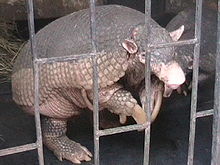| Tolypeutinae[1] Temporal range: Late Oligocene to present
| |
|---|---|

| |
| Captive giant armadillo in Colombia | |
| Scientific classification | |
| Domain: | Eukaryota |
| Kingdom: | Animalia |
| Phylum: | Chordata |
| Class: | Mammalia |
| Order: | Cingulata |
| Family: | Chlamyphoridae |
| Subfamily: | Tolypeutinae Gray, 1865 |
| Genera | |
| |

| |
Tolypeutinae is a subfamily of armadillos in the family Chlamyphoridae, consisting of the giant, three-banded and naked-tailed armadillos.[2][3][4]
- ^ Gardner, A. (2005). Wilson, D.E.; Reeder, D.M. (eds.). Mammal Species of the World: A Taxonomic and Geographic Reference (3rd ed.). Johns Hopkins University Press. pp. 94–95. ISBN 978-0-8018-8221-0. OCLC 62265494.
- ^ Moller-Krull, M.; Delsuc, F.; Churakov, G.; Marker, C.; Superina, M.; Brosius, J.; Douzery, E. J. P.; Schmitz, J. (November 2007). "Retroposed Elements and Their Flanking Regions Resolve the Evolutionary History of Xenarthran Mammals (Armadillos, Anteaters, and Sloths)". Mol. Biol. Evol. 24 (11): 2573–2582. doi:10.1093/molbev/msm201. PMID 17884827.
- ^ Gibb, G. C.; Condamine, F. L.; Kuch, M.; Enk, J.; Moraes-Barros, N.; Superina, M.; Poinar, H. N.; Delsuc, F. (2015-11-09). "Shotgun Mitogenomics Provides a Reference Phylogenetic Framework and Timescale for Living Xenarthrans". Molecular Biology and Evolution. 33 (3): 621–642. doi:10.1093/molbev/msv250. PMC 4760074. PMID 26556496.
- ^ Delsuc, F.; Gibb, G. C.; Kuch, M.; Billet, G.; Hautier, L.; Southon, J.; Rouillard, J.-M.; Fernicola, J. C.; Vizcaíno, S. F.; MacPhee, R. D. E.; Poinar, H. N. (2016-02-22). "The phylogenetic affinities of the extinct glyptodonts". Current Biology. 26 (4): R155–R156. doi:10.1016/j.cub.2016.01.039. hdl:11336/49579. PMID 26906483.